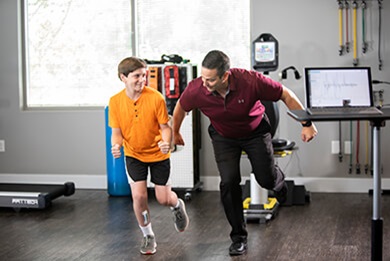Functional Movement Screens

Identifying movement patterns and preventing injuries
Athletes depend on strength, flexibility and mobility to perform at their best. A breakdown in an athlete’s movement patterns can lead to injury. Our sports physical therapy experts at Baylor Scott & White Institute for Rehabilitation - Outpatient Therapy are committed to helping you identify poor movement patterns and prevent injury with a movement screen and biomechanical analysis.
The Functional Movement Screen (FMS) is an innovative system used to evaluate and document seven movement patterns that are key to normal function. The screen is comprised of seven fundamental movement patterns that require a balance of mobility and stability. We place the individual in extreme positions where weakness and imbalances become noticeable. By screening these patterns, our team can easily identify your functional limitations and asymmetries. These are issues that can reduce the effects of functional training and physical conditioning.
The seven tests of the FMS:
- Deep squat
- Hurdle step
- In-line lunge
- Shoulder mobility
- Active straight leg raise
- Trunk stability push-up
- Rotary stability
Benefits of a Functional Movement Screen
We can use your score on the Functional Movement Screens to track recovery progress and identify exercises that will be most effective in restoring proper movement and building strength. This approach is beneficial to all levels of athletes and individuals because you can treatments are customized to the needs of each patient. The benefits of the FMS are as follows:
- A consistent and reliable testing method
- Easily identifies movement limitations and dysfunction
- Improves efficiency, durability, and performance
- Provides an enhanced foundation for exercise and performance programming
What to expect
Your physical therapist or athletic trainer will listen to you detail your specific sport or activity to learn how your movement patterns may be impacting performance. We use cutting-edge technology to provide an industry standard screening:
- dorsaVi™ Movement Suite and ViPerform™ Athletic Movement Index™ uses advanced 3D wireless and wearable sensors to measure motion, acceleration and muscle activity on different parts of your body.
- Fusionetics® uses 2D motion capture to assess how you move. It also includes a customizable app to track your corrective action progress plan.
Using this technology, your physical therapist or athletic trainer will take you through a variety of exercises to objectively assess your strength, balance, running technique, knee and hamstring movement and core function. You will be provided with a detailed report and video analysis that identifies your specific movement patterns.
Based on screening reports, your physical therapist or athletic trainer will develop a customized exercise program detailing corrective changes specific to your needs and goals.
Our goal is to utilize sports science, clinical application and technology to decrease your risk of injury, improve performance or reduce pain and enhance recovery should an injury occur.
Athletic Movement Index
At Baylor Scott & White Institute for Rehabilitation - Outpatient Therapy, we provide movement assessments that will take your training to the next level with our advanced sports science technology. Take your training to the next level with our advanced sports science technology. Using wireless wearable sensors and the ViPerform™ Athletic Movement Index (AMI™) to precisely measure how you move allows us to assess weakness, asymmetry and movement patterns that contribute to poor performance and lead to potential injury.
Our physical therapists use your movement analysis data to create a customized program just for you, reducing the risk for injury and improving athletic performance.
Take your sport training to the next level. Athletic Movement Index™ evaluations may benefit those with the following conditions:
- Achilles tendonitis /tendinosis
- Lumbar instability
- ACL injuries
- Medial tibial stress syndrome
- Ankle sprains
- Patellar femoral pain syndrome
- Calf strain
- Shin splints
- Snapping hip
- IT band syndrome
- Trochanteric bursitis
At risk sports may include:
- Basketball
- Lacrosse
- Cheerleading
- Rugby
- Volleyball
- Soccer
- Football
- Track and Field
- Field and Ice Hockey
